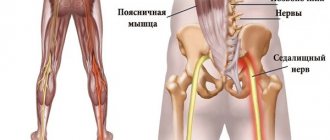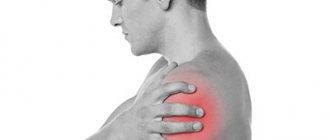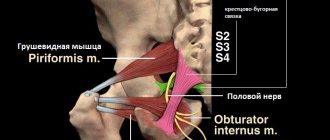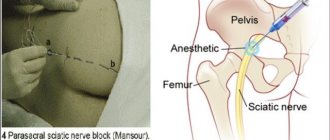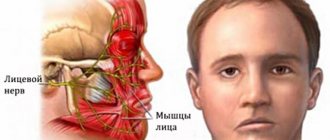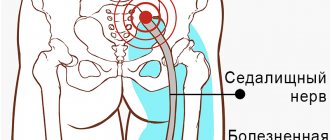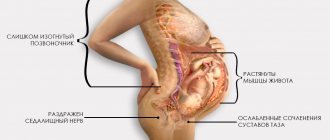There are traditionally many calls with complaints that the sciatic nerve has caught a cold during the cold season. But things are not always exactly as patients assume. They think that severe pain and limited mobility are the result of exposure to negative temperatures. Actually this is not true.
The sciatic nerve is the thickest in the human body. It is formed by several branches of the lumbar radicular nerves. It leaves the lumbosacral nerve plexus and goes to the entrance to the tunnel formed by the piriformis muscle. Not only the sciatic nerve passes inside it, but also large blood vessels. As you understand, this structure perfectly protects the nerve fiber from hypothermia even in severe frost.
In order to freeze the sciatic nerve, frostbite of the piriformis muscle must occur. Although there are exceptions. The small section along which the sciatic nerve follows from the exit from the lumbosacral nerve plexus to the entrance to the piriformis muscle does not have the same reliable thermal insulation. But again, in order to catch a cold, you need to be in the cold for several hours without clothes, excuse me, with a bare tailbone.
Therefore, it is necessary to understand that a cold sciatic nerve is most often a complication of another, long-term disease. For example, degenerative dystrophic destruction of intervertebral discs or deformation of the iliosacral joint of bones. Also, a similar clinical picture can be caused by plexitis, intervertebral hernia, instability of the position of vertebral bodies, spondyloarthrosis, changes in posture and a number of other serious pathologies of the spinal column and surrounding tissues.
In this article we will look at questions about what to do if the sciatic nerve is cold, what symptoms may occur and what treatment should be carried out to completely restore this part of the autonomic nervous system.
If you have pain along the sciatic nerve and you are in Moscow, then make a free appointment with a neurologist at our manual therapy clinic right now. An experienced doctor will conduct a full examination, make an accurate diagnosis and tell you how to properly carry out complex treatment. You will receive individual recommendations that will help you undergo examination and cope with the disease.
What is a pinched sciatic nerve?
The sciatic nerves start from the lower back, then go through the tailbone, pelvis and legs and end at the foot. When a pinched sciatic nerve is diagnosed, the most common concern is severe pain, cutting or stabbing. Pinching occurs on one side, but sometimes bilateral damage is diagnosed. If you do not see a doctor in time, the condition may worsen. In addition to pinching, there is also inflammation of the same nerve, which manifests itself with the same symptoms. Another name for this disease is “sciatica.”
Contraindications
Despite the obvious advantage of drug blockade of the sciatic nerve, it is not available to all patients. This treatment method is contraindicated:
- patients with cardiovascular, renal and hepatic pathologies;
- with increased sensitivity of the body to the components of injectable drugs;
- patients with severe central nervous system damage;
- if there is a history of hemorrhagic syndrome and infectious skin lesions.
For patients with diabetes, stomach ulcers and metabolic disorders, the procedure is performed only in emergency cases, according to the doctor’s opinion.
Causes
Pinched sciatic nerve is caused by the following reasons:
- Intervertebral hernia. This is the main cause of the disease. Intervertebral spacers fall out, which in a healthy person prevent the vertebrae from collapsing.
- Osteochondrosis. Metabolic processes in bone tissue are disrupted, causing them to grow and affect the spinal nerves.
- Spinal injury.
- Constant hard physical labor.
- Hypothermia, especially of the back.
Diagnosis for pain in the gluteal region
To identify the causes of pain and make a diagnosis, a physical examination by a neurologist is necessary. As objective methods of diagnostic search, in medical in Rostov-on-Don, high-precision modern equipment is used, which allows you to quickly determine the cause of pathological processes.
1) Using computed tomography, not only the structure of the bones, but also the vertebral discs are examined in detail. A tomograph is indispensable in diagnosing hernial protrusions, tumor formations and damage caused by trauma.
2) Magnetic resonance imaging examination allows us to identify the nature and extent of damage to the sciatic nerve plexuses and the features of the processes occurring in them.
The price for instrumental diagnostics is affordable. It includes the examination itself, its result on disk, and a transcript from the diagnostician.
Symptoms
Is this really a pinched sciatic nerve, symptoms and treatment can only be determined by a neurologist
. It is this specialist that you should contact if the following symptoms appear:
- pain, for some it is not severe, for others it is quite intense, it bothers you on one side, it intensifies when sitting;
- burning and tingling in the lower part of the leg;
- when walking, the leg hurts, there is a feeling of petrification;
- the pain becomes more intense when coughing, laughing, if a person stands for a long time or sits on something hard;
- Sweating of the feet may increase, the skin turns red, and swelling occurs.
If you have a pinched sciatic nerve, the symptoms vary, depending on how severely the nerve is affected. In especially severe cases, this disease may cause the leg muscles and gluteal muscles to shrink, and it becomes difficult to move the toes or turn the foot.
Diagnostics
Before eliminating the pinching, it is important to identify the provoking factors and the etiology of the development of the disease.
The disease is treated by a neuropathologist (neurologist) , who you should contact if you suspect sciatica or experience unbearable pain. To prescribe effective treatment, the doctor will refer you for a consultation with a neurosurgeon, physiotherapist, vertebrologist, or vascular surgeon.
First of all, the doctor will conduct a visual examination, check the degree of reflexes on the legs by tapping a hammer, and identify the degree of skin sensitivity. The examination is comprehensive.
The main diagnostic method is radiography with examination of images to confirm (exclude) degenerative changes in bone tissue.
Additional methods:
- radioisotope scanning of the spinal column if cancer is suspected;
- blood and urine tests;
- CT scan;
- Ultrasound.
How to treat a pinched sciatic nerve?
How to treat a pinched sciatic nerve? Treatment should be selected by a doctor after a detailed examination. You should not resort to self-medication - you can only worsen the situation. Let's talk about the main methods of treating a pinched sciatic nerve.
Massage
Massage for this disease is contraindicated, otherwise the patient’s condition may worsen. However, if the doctor recommended this procedure, you should not refuse. He or she may refer you to a specialist who specializes in these conditions. However, you should not do a massage yourself, especially before you go to a specialist.
Exercises
Exercise can help with recovery. However, if you have an acute pinched sciatic nerve, it is better to avoid them. Exercises should be performed only during the period of remission. Activities help when the load is evenly distributed on both legs, i.e. race walking or running, swimming, skiing. However, excessive loads are harmful, so running should only be light; skiing should be done leisurely. There are also special exercises, but only the attending physician should select such a complex of physical therapy. Exercise helps improve blood circulation in the legs and strengthens the muscles.
Drug treatment
If you have a pinched sciatic nerve, treatment includes taking various medications that should reduce the pain. When the disease worsens, pain-relieving injections are prescribed, which can be given intravenously, intramuscularly or into the epidural space. Local agents that improve blood circulation and relieve pain and swelling can also be used. To relax spasmodic muscles, vitamins B1 and B6 are prescribed.
Painkillers
How to cure a pinched sciatic nerve? Most often, the patient is prescribed painkillers, NSAIDs. These can be either over-the-counter medications (Aspirin, Ibuprofen, Ketoprofen) or prescription medications (Naproxan). However, it is necessary to take these medications correctly. Drinking them with food will reduce the likelihood of stomach discomfort. Otherwise, there is a high risk of developing an ulcer. Therefore, all medications must be prescribed by a specialist, strictly selecting dosages. He will also tell you how to take these medications correctly to reduce side effects.
Spa treatment
If you do not have an exacerbation, your doctor may recommend spa treatment, i.e. courses of underwater traction, mud therapy, pearl or hydrogen sulfide baths. This will not only help cope with the disease, but also strengthen the immune system, and also allow the patient to rest and recover, which is also necessary for recovery.
Yoga
Yoga can help cope with illness. Specially selected poses help relax muscles, reduce pain, and improve blood circulation. However, during periods of exacerbation, it is better to avoid yoga. Remember to warm up first, do a warm-up, and only then perform more complex exercises. It is advisable to talk with professionals who will help you choose the right set of asanas.
Electrophoresis
Doctors note that physiotherapeutic methods of treatment, including electrophoresis, have proven themselves well. It reduces pain, helps warm the affected area, removes swelling, and improves blood circulation.
Folk remedies
If you want to cure this disease at home using traditional methods, remember that they are unreliable, i.e. there is no guarantee that you will get better. However, if you feel that folk remedies help you, you can use them, provided that they are safe. A honey cake will help cope with the pain. To prepare it, you need to heat 1 tbsp in a water bath. l. honey and mix it with 1 tbsp. l. flour, make a flat cake. Place this flatbread on the sore spot, wrap it in cellophane and then with a warm scarf.
Treatment methods
Only complex therapy will eliminate unpleasant manifestations in the sciatic nerve. Primary treatment is medication to relieve the inflammatory process and relieve pain.
Additionally, physiotherapy, electrophoresis, Kuznetsov's applicator, herbal medicine, hirudotherapy and folk remedies, diuretics for swelling of the affected areas are indicated.
If medications become ineffective, then the only option left to eliminate the pinching is surgery, macrodiscectomy, or discectomy.
Drugs
The treatment is based on drugs from the NSAID group to provide an anti-inflammatory, analgesic effect:
- Meloxicam.
- Nimesulide.
- Movalis.
- Naproxen.
- Diclofenac.
- Amelotex.
Movalis
Diclofenac
Meloxicam
Naproxen
Nimesulide tablets
Amelotex
The action of other drugs is aimed at relieving neurogenic inflammation and normalizing local blood circulation:
- corticosteroids (Dexamethasone, Metipred) for acute neuropathy;
- decongestants (Furosemide, Sorbitol, Lasix);
- muscle relaxants (Relanium, Baclofen, Mydocalm, Phenibut);
- antioxidants (Cerebrolysin, Actovegin) to normalize the rheological properties of blood;
- biogenic stimulants and vegetotropic agents (Plasmol, Pyrogenal, Bioquinol, Eglonil, Platifillin, Phenazepam);
- multivitamin preparations with an anti-inflammatory effect (Trigamma, Neurovit, Milgamma, Neurobion, Combilipen).
Dexamethasone
Metipred
Furosemide
Baclofen
Mydocalm relaxes muscles
Actovegin for injection
For sciatica, local ointments help relieve pain with a warming irritating effect - Voltaren, Emulgel Apifor, Nayatox . Creams, gels with extract of capsicum, camphor - Viprosal, Capsicam, Finalgon, Nurofen.
Voltaren gel
Capsicum ointment
Nurofen
Viprosal
If severe pain bothers you, distractive anti-inflammatory drugs are prescribed - Efkamon, Apizartron, Menovasin, Dimexide, Vipraxin with topical application.
For severe pain due to neutropenia, trophic disorders, Pachycarpine, Benzohexonium can be used to normalize synaptic neuronal transmission. If the pain intensifies, then hormonal steroids are indicated.
Blockades
For unbearable pain in the joints, patients are prescribed injections of analgesics (Tramadol, Xefocam, Analgin) administered in the form of injections.
If the pain is not relieved by pills, then the doctor may decide to install blockades with a course of treatment of 3-4 days. This is an extreme measure for paroxysmal excruciating pain in the legs, after which painkillers are prescribed, but in pills.
Hormonal injections are used in rare cases for severe inflammation, swelling in the soft tissue and pelvis area. It is possible to introduce blockades using local anesthetics (Ultracaine, Novocaine) into the area of the sciatic nerve bundle or into the lower back to completely block nerve impulses.
Physical therapy and exercise
Exercise therapy is an indispensable part of therapy for sciatica and pinched nerves. It is carried out during the rehabilitation period, when the pain syndrome begins to subside. A set of special exercises is developed by the attending physician. The goal is to distribute an even load on both sides of the body.
You can use proprietary techniques aimed at solving specific problems. Dr. Bubnovsky has developed a set of exercises that will help get rid of lower back pain.
One of the exercise options is performed up to 10 times, so up to 8-10 sessions in a row with a duration of 35 minutes, gradually increasing the load:
- Bring your legs towards your body , hug them under your knees with your arms, pressing them towards you. Hold the position for 35 seconds.
- Align your legs at attention . Raise your toes up, hands at your sides. Stretch on your heels, sway in different directions, so on for up to 15 minutes, then relax.
- Turn to your side, pull your legs towards your stomach. Pull your socks slightly.
- Lying on your stomach, lift your torso with your arms, doing push-ups and without straining your legs too much.
Incorrect manipulation can only worsen the situation and lead to increased unpleasant pain symptoms.
Physiotherapy
Physiotherapy gives a good effect for sciatica, the main types are:
- magnetic therapy and laser therapy;
- electrophoresis using Diclofenac;
- ultrasound and shock wave therapy;
- darsonval procedure and UHF;
- massage and acupuncture.
The purpose of physiotherapy is to eliminate pressure on the nerve roots, restore sensitivity (mobility) of the legs, prevent possible relapses of the underlying disease, and promote muscle relaxation.
The Almag device helps well with sciatica. If you combine the use with massage, the pain will gradually disappear, muscle tone will decrease, swelling and stagnant manifestations of lymph in the affected area.
Massage and manual therapy
Massage is indicated for sciatica for the buttock, lumbar part, legs, feet, thighs. It is advisable to conduct 8-10 sessions lasting up to 30 minutes to achieve lasting results.
When performing a massage, you can treat the affected areas with ointments or combine massage with therapeutic exercises to normalize blood circulation in the affected areas. It is recommended to massage the lumbar area, thighs, legs and feet.
In combination with therapeutic exercises and under the guidance of an experienced instructor, massage brings quite good results.
Prevention
How to prevent the occurrence of such a serious disease? There are several rules that everyone who cares about their health must follow:
- Don't overload yourself. Physical activity should be moderate.
- If you work in an office, at a computer, organize your workspace correctly, make sure that the chair is not too low or soft.
- Sleep on a hard surface or buy an orthopedic mattress.
- Regularly do exercises that strengthen your back muscles, and walk more.
- Try not to get too cold.
A pinched sciatic nerve is a serious condition that is difficult to treat. As soon as the first symptoms appear, it is better to consult a doctor. Painkillers, physiotherapy, spa treatment, etc. will help cope with the disease. However, it is still better to prevent it by following simple rules.
Treatment during pregnancy
In women during late pregnancy, pinching (irritation) of the nerve trunk often occurs. The reason is that the load on the spinal column increases.
A pregnant woman should be treated by a qualified neurologist:
- A vertebrologist may prescribe exercises to stretch the spine and relax the muscles around the circumference.
- If the pain is caused by neuritis (rheumatism) , then therapeutic exercises to strengthen the back muscles, herbal compresses with alcohol to normalize blood flow, and baths with dissolved salt 12 kg per 135 liters of water will help.
- relieve severe pain , since many medications for pregnant women are prohibited. The therapy will improve tissue microcirculation in the affected area, relieve muscle spasms, and neutralize inflammatory manifestations.
- Physiotherapy (acupuncture, massage) is prescribed in a gentle manner and in comfortable conditions.
Pinching disrupts the ligamentous and muscular bone structures of the legs, but in expectant mothers it often occurs in the form of the flu (tuberculosis, syphilis, herpes, herpes zoster), which makes it difficult to make an accurate diagnosis. Women are advised to take care, avoid physical activity, and during attacks of nerve inflammation, stay in bed.
